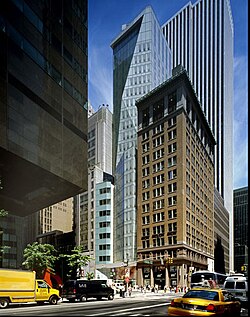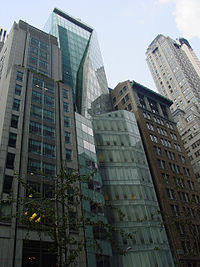LVMH Tower
| LVMH Tower | |
|---|---|
 | |
 | |
| General information | |
| Architectural style | Postmodern Art Deco |
| Address | 19East 57th Street New York,NY10022 U.S. |
| Coordinates | 40°45′45.66″N73°58′21.55″W/ 40.7626833°N 73.9726528°W |
| Current tenants | LVMH Moët Hennessy Louis Vuitton SE |
| Opened | December 8, 1999 |
| Technical details | |
| Floor count | 24 |
| Design and construction | |
| Architect(s) | Christian de Portzamparc |
| Structural engineer | Weiskops and Pickworth |
| Other designers | Hillier Group (associate architects and interior design) |
TheLVMH Toweris a 24-storyhigh-riseoffice tower on57th Street,nearMadison Avenue,inMidtown Manhattan,New York City.Designed byChristian de Portzamparc,the building opened in 1999 as the overseas headquarters ofParis-basedLVMH Moët Hennessy Louis Vuitton SE.The building has received widespread praise from architecture critics.
Architecture[edit]
Facade[edit]

The building occupies a narrow site between a 1920s bank building and the 1995 American headquarters ofChanel S.A.(designed byCharles Plattafter de Portzamparc had completed his design for the LVMH Tower).[1]It is across 57th Street from590 Madison Avenue,formerly theIBMBuilding.[2]In contrast to all of these, it is clad in glass. An eleven-story base includes ground-level store space forChristian Dior,designed byPeter Marino,[3][4]with a metal strip above it that acts as a unifying element.[5]The tower itself has a complex, angular facade divided into two sections along the diagonal, with the right (east) side projecting and bent in the middle, producing a geometry that has been described as feminine, like the fall of a skirt over a bent knee,[5][6][7]and also, including by de Portzamparc himself, as resembling the unfolding petals of a flower.[1][8]A blue glass cube at the center of the fold on the 10th floor resembles a gem.[1][8][9]The glass on the left (west) side is green, withfritteddots;[6]on the right side, it is milky white, with each window divided at an angle into a sandblasted half and a clear half with sandblasted lines across it that grow wider on higher floors.[1][7]The facade also uses ultra-clear low-iron glass. It has set a precedent for other buildings erected by manufacturers of luxury goods.[10]
At night, the white section of the building is lit pale green and violet and the other half recedes; neon tubes under the front fold provide a slash of changing colored light.[1][5][7][11][12]
The folded facade with its protrusion is an innovative interpretation of the requirement forsetbacksin New York City's building code,[3][5][13]with a void in the lower section and with the upper section folding back outward in a prismatic rather than a "wedding-cake" shape.[6]Having the building touch the mandated setback line at the minimum two points and folding it inwards from the base to the top made it possible for it to be taller than the neighboring Chanel Building.[14][15]
Interior[edit]
Each business within the LVMH group has its own floor in the building.[16]The interior design, by the Hillier Group, de Portzamparc's U.S. associate architects on the project, features glass, pressed wood, and metal in the elevator lobby and a glass-enclosed cubic reception space on the top floor, three floors or thirty feet high, made possible by the savings in floor space below, which LMVH calls the Magic Room.[1][14][17]This is entered in dramatic fashion down a curving stairway from amezzaninefloor.[1][6]
History[edit]
Ground was broken for the building in 1996, but work was then largely halted for four years by disagreements over financing with the landlord, Robert Siegel,[18]and logistical problems with manufacturing the components in multiple countries.[1][3]The building opened on December 8, 1999, with a gala that included a model wearing aGallianogown whose 60-foot train cascaded down the facade.[3][19]
A planned addition, including an obelisk echoing the IBM Building and a slab of fritted glass at the Madison Avenue corner, was canceled in 2001 because of the economic downturn.[20]
Critical reception[edit]
The LMVH Tower has met with praise from architecture critics.Architecturecalled it "one of the most serious and significant structures in the city in recent years".[6]Ada Louise Huxtable,writing in theWall Street Journal,called it "the epitome of controlled, refined elegance", "the best new building in New York—not by small degrees but by the equivalent of a jump shot to the moon".[3]Herbert Muschamp,writing inThe New York Times,called it "[t]he most important building to be completed in New York in years.... [a reinvention of] the spirit of Art Deco",[21]but said that rather than merely imitating Art Deco skyscrapers of the past, the building "deforms the style in order to reinvigorate its fresh, jazzy spirit".[1]Paul Goldberger,writing inThe New Yorker,called it "exactly right for the city at this moment", "a stunning, lyrical building";[22]however, with the exception of the "Magic Room" he was disappointed by the interiors, calling the offices "dull, flat spaces".[23]TheArchitecturecritic also called this "the one great space" and referred to the elevators and offices as "cram, not glam" and "stuffed".[6]Huxtable noted that the small lobby was intended to seem larger by means of lighted white glass panels, but in her opinion the addition of decoration had defeated the effect.[14]
References[edit]
- ^abcdefghiHerbert Muschamp,"The Spirit of Deco Rises from the Dead,"ArchivedNovember 30, 2023, at theWayback MachineThe New York Times,June 27, 1999.
- ^Goldberger, pp. 112–113.
- ^abcdeHuxtable,p. 286ArchivedApril 1, 2024, at theWayback Machine.
- ^Ginia Bellafante,"Front Row,"ArchivedMarch 6, 2016, at theWayback Machine,Style,The New York Times,November 30, 1999.
- ^abcdEric Peter Nash and Norman McGrath,Manhattan Skyscrapers,rev. ed. New York: Princeton Architectural Press, 2005,ISBN9781568985459,p. 169ArchivedApril 1, 2024, at theWayback Machine.
- ^abcdef"25 Floors of Glamour,"Architecture,March 2000, quoted in Rosario Caballero,Re-Viewing Space: Figurative Language in Architects' Assessment of Built Space,Applications of cognitive linguistics 2, New York: Mouton de Gruyter, 2006,ISBN9783110185201,pp. 55–57ArchivedApril 1, 2024, at theWayback Machine.
- ^abcGoldberger, p. 113.
- ^ab"Torre LVMH", in Ariadna Àlvarez Garreta, tr. Mark Holloway,Skyscraper Architects,Barcelona: Atrium, 2004,ISBN9788495692405,pp. 154–159, p. 154.
- ^LeBlanc,p. 248ArchivedApril 1, 2024, at theWayback Machine,refers to it as a pyramid.
- ^Scott Charles Murray,Contemporary Curtain Wall Architecture,New York: Princeton Architectural Press, 2009,ISBN9781568987972,p. 59ArchivedApril 1, 2024, at theWayback Machine.
- ^Garreta, p. 156.
- ^Höweler, p. 166.
- ^Höweler, pp. 166–167.
- ^abcHuxtable, p. 289.
- ^Philip Jodidio,Architecture Now!,Cologne/London: Taschen,ISBN9783822860656,p. 486ArchivedApril 1, 2024, at theWayback Machine.
- ^LeBlanc, p. 248.
- ^Goldberger, pp. 114–115.
- ^Sharon Edelson,"Deadlock broken on LVMH tower in N.Y. (construction of LVMH Moet Hennessy Louis Vuitton's New York, NY, building held up by Robert Siegel suit),"Women's Wear Daily,July 24, 1997
- ^Suzy Menkes,Bernard Arnault: Man Behind the Steely Mask, "ArchivedMarch 5, 2016, at theWayback MachineStyle,The New York Times,November 30, 1999.
- ^Herbert Muschamp,"A Lesson Abroad: Get Comfortable with Continuity"ArchivedMarch 5, 2016, at theWayback Machine,The New York Times,February 24, 2002, repr. inHearts of the City: The Selected Writings of Herbert Muschamp,New York: Knopf/Borzoi, 2009,ISBN9780375404061,pp. 689+,p. 691ArchivedApril 1, 2024, at theWayback Machine.
- ^Herbert Muschamp,"New York Starts to Look Beyond Its Past,"ArchivedSeptember 18, 2017, at theWayback Machine1999: The Year in Review—Arts/Architecture,The New York Times,December 26, 1999.
- ^Goldberger, pp. 112, 114.
- ^Goldberger, p. 114.
Sources[edit]
- Paul Goldberger,"Dior's New House,"The New Yorker,January 31, 2000, repr. inBuilding Up and Tearing Down: Reflections on the Age of Architecture,New York: Random House/Monacelli, 2009,ISBN978-1-58093-264-6,pp. 111–115.
- Eric Höweler,Skyscraper,New York: Rizzoli/Universe, 2003,ISBN9780789310057,pp. 166–167
- Ada Louise Huxtable,"French Elegance Hits Midtown Manhattan",The Wall Street Journal,January 10, 2000, repr. inOn Architecture: Collected Reflections on a Century of Change,New York: Walker/Bloomsbury, 2008,ISBN9780802717078,pp. 285–290.
- Sydney LeBlanc, "LVMH Tower, 1999" inThe Architecture Traveler: A Guide to 250 Key 20th Century American Buildings,New York: Norton, 2000,ISBN9780393730500.
External links[edit]
- LVMH Louis Vuitton-Moët Hennessy Towerat NYC Architecture
